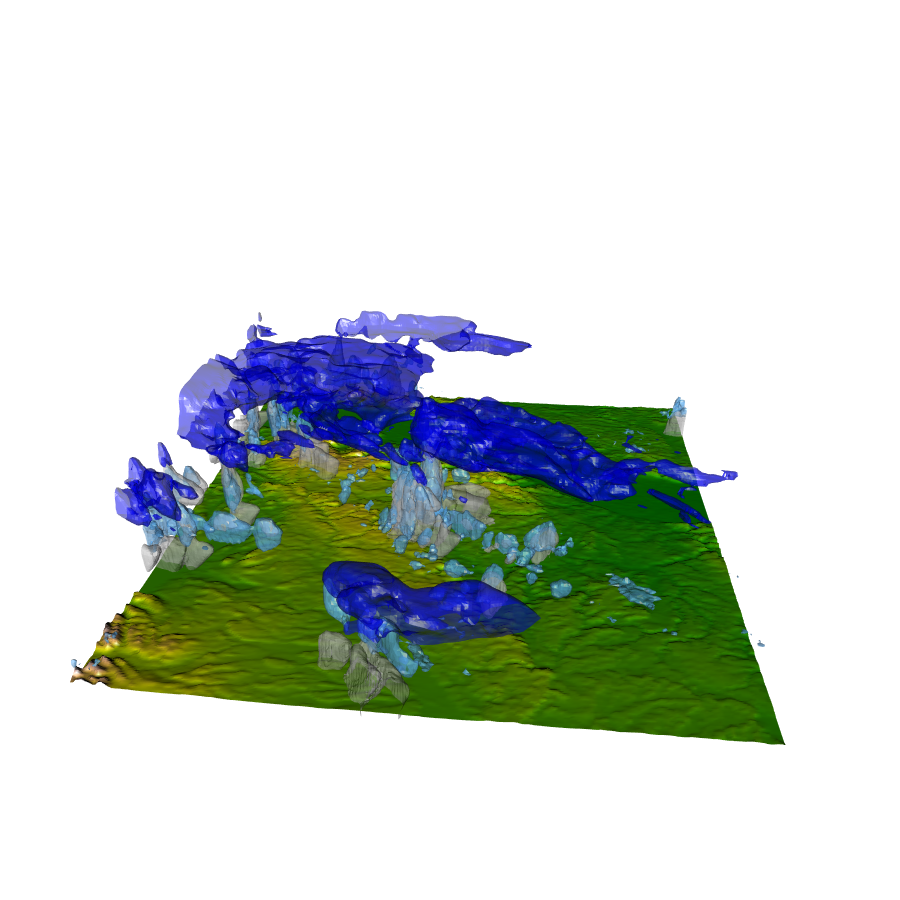Introduction
Aerosol-cloud interactions (ACI) are among the most uncertain processes in numerical weather prediction models. The effects of aerosols on clouds and precipitation vary significantly depending on the cloud type. Generally, high aerosol concentrations are assumed to activate more aerosol particles as cloud condensation nuclei (CCN), resulting in a larger number of smaller cloud droplets. This smaller droplet size suppresses the onset of precipitation in warm clouds by reducing the collision-coalescence process, leading to longer cloud lifetimes. Under polluted conditions, the increased water load at the freezing level can release additional latent heat, potentially invigorating convective clouds and enhancing rainfall. However, recent studies highlight that cloud responses to changes in aerosol concentrations differ depending on the cloud type, aerosol regime, and environmental conditions. This project investigates how microphysical uncertainties influence cloud formation and subsequent precipitation across various weather regimes and scales.

Fig. 1: Simulation of a supercell storm at 1-km grid resolution using a sophisticated double-moment microphysics scheme. Cloud water (blue), rainwater (gray), and cloud ice (dark blue) are shown.
| Principal investigator: | Dr. Christian Barthlott |
| Project manager: | Dr. Christian Barthlott |
| Researchers: | Dr. Gabriella Wallentin, M. Sc. Miriam Simm |
| Date published: | February 2025 |
| HPC platform used: | HoreKa |
| Institute: | Institute of Meteorology and Climate Research Troposphere Research (IMKTRO) |
| Affiliation: | Karlsruhe Institute of Technology (KIT) |
| Research field: | Atmospheric Science |
| Project ID: | ACI |
Project description
Method
We perform numerical sensitivity studies using the ICOsahedral Non-hydrostatic (ICON) model (Zängl et al., 2015) for convective scenarios in central Europe and other regions globally. The model operates with horizontal grid spacings ranging from 2 km to 150 m, primarily in ensemble mode, involving multiple realizations of a single case with perturbed initial and boundary conditions or modified uncertain physical parameters.
Results
We generate a large 108-member ensemble by varying four microphysical parameters: CCN concentration, ice nucleating particle concentration, graupel sedimentation velocity, and the width of the cloud droplet size distribution. These parameters naturally exhibit considerable variability. Our findings reveal significant spatial precipitation variability and a substantial impact on total precipitation amounts. Notably, the ensemble achieves a spread comparable to that of operational ensembles, which is remarkable given the identical initial and boundary conditions used.
For one case from the 2021 Swabian MOSES field campaign, a supercell storm in southwestern Germany displayed an extraordinary 7.5-hour lifespan. The storm traveled nearly 190 km and produced substantial hail. Hindcasts of this event using the ICON model indicate that a realistic simulation of the storm is achieved only with a combination of high grid resolution and low CCN concentrations (Fig. 1). These findings underscore the advantages of employing an aerosol-aware double-moment microphysics scheme for convective-scale predictability. Furthermore, variations in CCN concentrations can determine whether a supercell is accurately simulated (Barthlott et al., 2024).
References
Barthlott, C., B. Czajka, M. Kunz, H. Saathoff, H. Zhang, A. Böhmländer, P. Gasch, J. Handwerker, M. Kohler, J. Wilhelm, A. Wieser and C. Hoose (2024): The Impact of Aerosols and Model Grid Spacing on a Supercell Storm from Swabian MOSES 2021, Q. J. R. Meteorol. Soc. 150, 2005-2027, DOI:10.1002/qj.4687
Zängl, G., D. Reinert, P. Rípodas, and M. Baldauf. The ICON (ICOsahedral Non-hydrostatic) modelling framework of DWD and MPI-M (2015): Description of the non-hydrostatic dynamical core. Q. J. R. Meteorol. Soc., 141:563–579.
